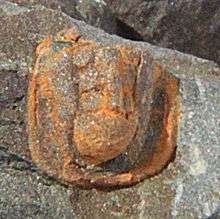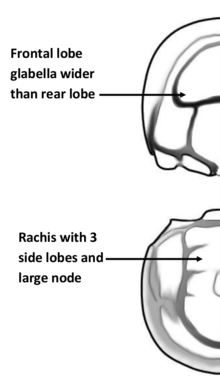Condylopyge
Condylopyge is a genus of very small trilobites, that lived during the latest Early and the early Middle Cambrian, in what are today Canada (Newfoundland and New Brunswick), Czech Republic, England and Wales, France, Germany, Italy, Morocco, the Russian Federation (North-East Siberia), Spain, Turkey and Sweden. It can easily be distinguished from all other Agnostida because the frontal lobe of the central raised area of the headshield (or glabella) is wider than the rear lobe. It looks like Pleuroctenium but the frontal glabellar lobe does not fold around the rear lobe, as it does in Pleuroctenium.
| Condylopyge | |
|---|---|
 | |
 | |
| Cephalon (top) and pygidium (bottom) of Condylopyge rex | |
| Scientific classification | |
| Kingdom: | |
| Phylum: | |
| Class: | |
| Order: | |
| Suborder: | Agnostina |
| Superfamily: | Condylopygoidea |
| Family: | |
| Genus: | Condylopyge Hawle & Corda, 1847 |
| species | |
| |
| Synonyms | |
|
Paragnostus, Fallagnostus | |
Distribution
- C. antiqua was excavated from the latest Lower to the early Middle Cambrian of Italy (Campo Pisano Formation, 4 km south-east of Fluminimaggiore, Iglesiente area, South-West Sardinia).[1]
- C. imperator were found in the early Middle Cambrian of France (Paradoxides beds, Herault, Languedoc).[2]
- C. carinata is present in the early Middle Cambrian of Morocco (A. birameus beds, Tissafin stage, Jbel Wawrmast Formation, Feijas internes group, Touchagt near Tinedjad, in the North of Alnif).[3]
- P. cruzensis has been identified from the early Middle Cambrian of Spain (Acadoparadoxides mureroensis trilobite zone, Valdemiedes Formation, Aragon).[4]
- C. matutina is present in the Middle Cambrian of Turkey (Çal Tepe Formation, near Seydişehir, Central Taurides).[5]
- C. rex has been collected from the early Middle Cambrian of the Czech Republic (E. pusillus-zone, Týřovice an Skryje, Bohemia),[6] and Spain (Badulesia-zone, Los Villares Formation, Sierra de Córdoba).[7]
- a C. sp. occurs in the early Middle Cambrian of the United States (Chamberlain's Brook Formation, Braintree Member, Hayward's Quarry, Massachusetts).[8]
- a C. sp. also occurs in the early Middle Cambrian of Spain (Solenopleuropsis thorali trilobite zone, Genestosa Member, Oville Formation, Los Barrios de Luna, León).[9]
Description

Like all Agnostida, Condylopyge is diminutive, with the headshield (or cephalon) and tailshield (or pygidium) of approximately the same size (or isopygous) and outline, and only two thorax segments. The characteristic sidewise expansion of the frontal lobe of the glabella, occipital structures instead of basal lobes, and a rhachis with three pairs of side lobes and a rear lobe differentiate Condylopygidae from all other agnostids. Condylopyge can easily be distinguished from its sister taxon Pleuroctenium because the frontal glabellar lobe does not wrap around the sides of the rear lobe, giving it a mushroom-like appearance. The frontal glabellar lobe is never dissected lengthwise, unlike in Pleuroctenium, where this is often clearly visible. The pygidium may carry a pair of backwardly directed spines, but this also occurs regularly in Pleuroctenium.[6]
References
- Mergl, M.; Elicki, O. (2004). "Cambrian lingulid and acrotretid brachiopods from the Iglesiente area (Campo Pisano Formation, southwestern Sardinia)". Rivista Italiana di Paleontologia e Stratigrafia. 3 (110): 581–589.
- Howell, B. F. (1935). "Cambrian and Ordovician trilobites from Herault, southern France". Journal of Paleontology. 3 (9): 222–238.
- Mykerinos. "Condylopyge cf. carinata". Forum des chercheurs de trilobites. Retrieved 20 May 2013.
- Garcia-Bellido, D. C.; Dies Alvarez, M. E.; Gamez Vintaned, J.A.; Linan, E.; Gozalo, R. (2011). "First report of Crumillospongia (Demospongea) from the Cambrian of Europe (Murero biota, Spain)". Bulletin of Geosciences. 3 (86): 641–650. doi:10.3140/bull.geosci.1253.
- Dean, W.T. (2005). "Trilobites from the Çal Tepe Formation (Cambrian), near Seydişehir, Central Taurides, Southwestern Turkey" (PDF). Turkish Journal of Earth Sciences (Turkish J. Earth Sci.) (14): 1–71.
- Whittington, H.B. et al. Part O, Treatise on Invertebrate Paleontology. Revised, Volume 1 – Trilobita – Introduction, Order Agnostida, Order Redlichiida. 1997
- Liñan, E.; Dies, M.E.; Vintaned, J.A.G.; Gozalo, R.; Mayoral, E.; Muñiz, F. (2005). "Lower Ovetian (Lower Cambrian) trilobites and biostratigraphy of the Pedroche Formation (Sierra de Córdoba, southern Spain)". Géobios. 38: 365–381. doi:10.1016/j.geobios.2003.11.007.
- Geyer, G.; Landing, E. (2001). "Middle Cambrian of Avalonian Massachusetts: Stratigraphy and correlation of the Braintree trilobites". Journal of Paleontology. 1 (75): 116–135. doi:10.1666/0022-3360(2001)075<0116:mcoams>2.0.co;2.
- Zamora, S.; Smith, A.B. (2008). "A new Middle Cambrian stem-group echinoderm from Spain: Palaeobiological implications of a highly asymmetric cinctan". Acta Palaeontologica Polonica. 53: 207–220. doi:10.4202/app.2008.0204.